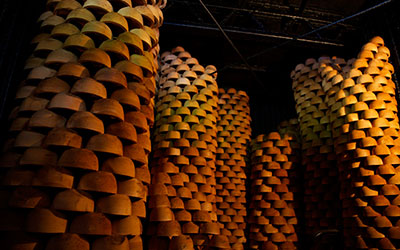

We respect the hand craftsmanship and use it as a tool for learning to make exquisite products that can be used time and time again over a lifetime and be loved by our customers.
To be able to enjoy the food by finding pleasure in the wares in which it is presented has always been a key component of Japanese food culture. We wish to safehold this tradition and pass it onto future generations. To make products that can communicate this connection, that are beautiful and of fine quality as well as serve a simple function is what we strive for in our craftsmanship.
Our Kawatsura lacquerware is an one hundred percent natural product with all of our materials sourced from within Japan. The sap we use for the lacquer is taken from trees that have reached at least 15 years of age. Our entire process uses only raw naturally produced materials so we cannot continue with our production without respecting, protecting and living alongside nature. As a gift from nature, we carefully use these raw materials and we are careful not to allow any waste. In our crafting we continuously give thanks for the blessings Mother Nature has provided and hope our finished product can reflect her bounty.

As a designated traditional art form of Japan, Kawatsura Lacquerware production begins with the felling of a tree. Once a tree in our woodland has reached a certain size it is felled. There are two options for slicing the tree for wood so called sideways and vertical. Traditionally our lacquerware uses the sideways cutting where the tree is sliced along the length of the grain. The wood when cut in this way has long been known to have a natural robustness, a fact recently proven when a study conducted showed that products made from this cutting technique have double the strength of those cut in the vertical technique. We then smoke dry the log at a low temperature over many hours to allow for water evaporation. As water evaporates the log shrinks and hardens and this smoking process also acts as a natural insecticide. The dried log is hard and because of this hardness the craftsman is able to manipulate the log into the rough shape of the final product on a wheel, with a saw and a lathe.

The process starts with a coating of persimmon sap and raw lacquer creating the base work for many more layers of further lacquer. This groundwork coating is one of the three keys to the durability of our Kawatsura lacquerwares. Jujiro developed a technique of lacquering where each layer has a different mixture and character, (raw lacquer, lacquer with a touch of charcoal powder, rice glue, another layer of charcoal powder etc.) Multiple coatings are applied. This technique and the inherent resulting fine quality can only be found in Kawatsura lacquerware. The final product that has been finished in many layers of lacquer creates a robustness that is the characteristic of Kawatsura lacquerware. We don`t add any layer of oil or other such products and strictly adhere to Jujiro`s technique. When combined with the skill of our craftsmen this results in an exquisite product with a smooth glossy finish. As craftsmen we are proud to show you what we can do by leaving no aberration in the lacquer nor any sign of brushwork. Our work takes time, but by adhering to these traditional methods ensures a product that not only can withstand everyday use but grow in beauty as it ages creating a special keepsake for both you and your family for generations.
Once the bowl has finished the process of lacquering there is the option of decorating the piece. The art of gold inlay can be performed on the finished bowl. First a design is carved lightly onto the surface of the bowl. Once a design is fully completed the carved area is rubbed with raw lacquer, and then fine gold leaf is pressed onto the carved design. Beyond gold leaf we also can decorate with gold dust powder, vermillion red, blue or other colored powders. This art of inlay is particular to lacquerware and is something we are very skilled at in Kawatsura.
The traditional exquisite art of Maki-e is another form of decoration we can add to our lacquerware. The technique of Maki-e uses a special kind of brush to mark out the desired underlying fine design in raw lacquer and then gently a mix of metallic powders are layered with another brush within the lines and then left to harden.
We proceed in the order of okime, sitae (hiragai), konamaki (keuchi), konamaki.


To make our bowls we cut our wood along the grain. This creates a robust product that can well withstand pressure from the top rim to the base.
Because of our choice to cut wood in this way our products are efficient in the utilization of natural resources and maintain sustainability.

Using the same wood for the fire, we smoke dry our wood over a low heat for several hours. This serves two purposes:
1. The final product is able to be withstand stress and is protected against distortion from humidity.
2. The smoke when mixing with the natural proteins in the wood rigidifies the grain preventing decay and acts as a natural insecticide.